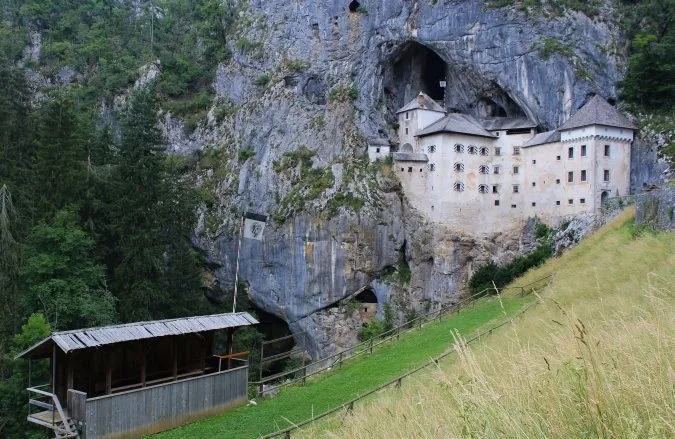The Predjama Castle is one of the most tourist spots in Slovenia, and proximity to the caves of Postojna makes it a very busy place, especially between spring and autumn. Therefore, to avoid the crowds and the queues for the many buses with organized trips that arrive at the car park, we recommend coming early or late, being able to enjoy a splendid photograph from many places.
 |
| Predjama Castle Slovenia |
Nailed like a thumbtack in the spectacular stone face of the mountain, Predjama Castle is a "mouth" to the cave where the mystery character of Baron Erazem Luegger (son of the governor of Trieste Nikolaj Lueger), narrated in Slovenian legends, was hidden after attacking the assaults on the merchants that covered the route that linked Vienna with Trieste. This Slovenian Robin Hood is known as the “good bandit”.
 |
| Predjama Castle Slovenia |
The fortress seems impregnable but throughout its history it has experienced multiple events that show that despite its verticality and difficult access, it could not always defend itself. Built in the 12th century, however, it was not until the middle of the 13th century that the first testimonies appear that mention it with the name of Luegg, mentioned as the property of the nobles of the Patriarchate of Aquileia. In the 14th century the Austrian dukes took possession of it, and in 1398 a siege culminated in the fire that destroyed it. The arrival of the Lienz knights in Tyrol brought the castle back to life.
 |
| Predjama Castle Slovenia |
The castle became famous thanks to the legend of the knight Erazem Lueger, who faced the Haubsburgs over a dispute in which he killed a bailiff. Hidden in the castle of Predjama, the baron, allied with the Hungarian King Matthias Corvinus, attacked the settlements related to the Haubsburg, and King Frederick III. The siege of the Lord of Trieste Gaspar Ravbar of one year and one day did not get him out of the fortress, and the besiegers did not understand how he could supply himself, including the cherries that he threw from the castle to mock the troops that harassed him. What they did not know is the network of caves that allowed (according to legend) to go out and collect food in the towns of the Vipava valley.
Unfortunately for the knight, the betrayal of some servants laid his neck on a platter when the baron apparently went to an area exposed to the cannon fire to go to the bathroom. The traitor gave the warning, and an accurate cannon shot ended Erazem's life.
 |
| Predjama Castle Slovenia |
The current physiognomy of the castle dates from 1570, the work of a reconstruction by the Baron von Cobenzl (after the cession of the Archduke of Austria), which expanded its original size, and maintaining this Central-European Gothic style until today.
After the Second World War the castle was confiscated by the Yugoslav authorities and nationalized.
It is worth going down to the Lokva River to capture the imposing perspective of the castle embedded in the rock, looking magical, especially in winter, when the snow whitens the green fields. The waters of the river are swallowed up by the earth, disappearing its course.
Between the months of May to September it is possible to visit the picturesque cave of the castle inhabited by bats that hibernate in the cold months, and therefore cannot be accessed so as not to disturb them.
Visit to the castle
After paying the entrance to the castle, we can start the visit through the rooms, the chapel, the old dungeon or the stables that were a part of the original cave. On the walls of the halls there are historical oil paintings and an image of the Pietà from the year 1420.
One of the most curious parts is to walk the corridor that leads to the cavern of the natural cave, from where the view of the place cheers the eye.
In front of the castle, re-enactments of medieval jousting are held during the summer months, very lively and crowded, and especially with a movie set.
How to get
The castle is in an incomparable natural setting, barely 10 km from the Postojna caves.
The castle is in the historical region of Inner Carniola, in south central Slovenia.